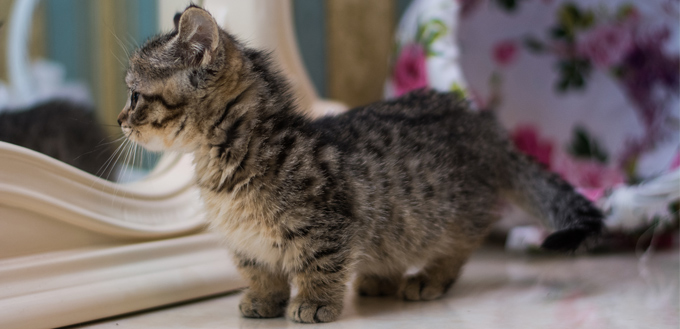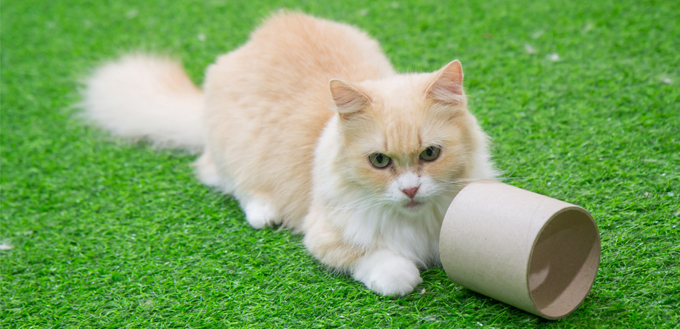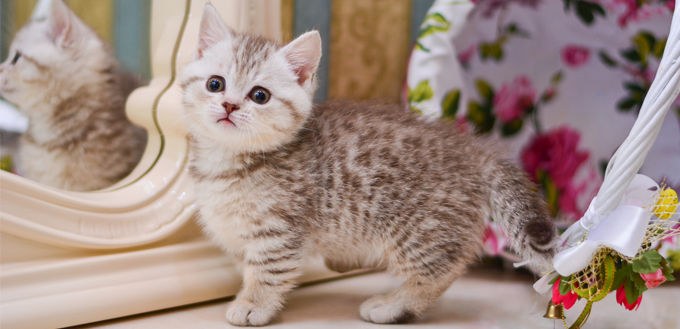You’ll be forgiven for thinking that the Munchkin is a cross between a Persian (or is it a British Shorthair?) and a Dachshund. It has this dwarfed appearance that is very uncharacteristic of a kitty. After all, we’ve always regarded kitties as exceptional climbers. But don’t ever underestimate this low-riding feline. It may have the shortest limbs in the cat kingdom, but it’s never short on playfulness, enthusiasm, and energy. This is one kitty that knows how to compensate for its short limbs by having lengthy fun.

History of the Munchkin Cat
Some folks don’t consider the Munchkin as a breed. That is why when The International Cat Association recognized it as a breed in 2003, many cat fanciers objected to its recognition. The Cat Fanciers’ Association and even the Governing Council of the Cat Fancy refused to acknowledge the Munchkin as a kitty breed. Only the TICA, the United Feline Organization, the American Association of Cat Enthusiasts, the Waratah National Cat Alliance, and the Southern Africa Cat Council recognize the breed.
And why do major cat organizations refuse to recognize the adorable Munchkin as a breed? Could it be because it is so cute that people are afraid it might dethrone the likes of the Maine Coon, the Persian, the Siamese, and the Ragdoll?
The answer lies in its genes.
You see, the short-legged nature of the Munchkin was the result of a natural, albeit still-unexplained genetic mutation that somehow affected only the genes that code for the length of the cat’s limbs. Cat fanciers have observed that these short-legged cats have been around since the 1940s. A 1944 British veterinary report described 4 generations of short-legged cats that were deemed as healthy as any other breed of cat, except for the short legs. These short-legged cats somehow ‘disappeared’ at the height of the Second World War and began reappearing in 1956 in Russia and in the 70s in the US.
A Louisiana music teacher named Sandra Hochenedel found in 1983 two pregnant short-legged cats hiding under a truck. Hochenedel kept one of the short-legged kitties and named her Blackberry. When Blackberry gave birth, half of her kittens had short legs, too. Hochenedel gave a short-legged male kitten to Kay LaFrance which she named Toulouse.
Since Toulouse was never kept exclusively indoors, it began mating with other neighborhood cats. Not long after, the neighborhood was already seeing an increasing number of short-legged kitties. This prompted Hochenedel and LaFrance to get in touch with Dr. Solveig Pflueger, the chairperson of the genetics committee of the TICA. LaFrance and Hochenedel believed that they have discovered a new breed of cat.
Dr. Pflueger, on the other hand, enlisted the help of Kansas State University College of Veterinary Medicine Radiology Department Head Dr. David Biller in finding out more about these short-legged cats. The primary concern was that the short-legged nature of the cats may follow the same pattern of disease-causation in short-legged dogs like the Dachshund and the Corgi. When the two scientists were able to establish an autosomal dominant pattern of inheritance and that the cats did not show any short-leg-associated spinal problems, the TICA decided to finally present the Munchkin to the public in 1991 by hosting a cat show that was televised on the national network.
This did not sit well with the other members of TICA and other cat organizations. They pointed out the risk of hip, back, and leg problems that are typically associated with short-legged animals, but most especially Dachshunds. In protest, a veteran show judge resigned his commission while calling the Munchkin as an insult to ethical cat breeders. It is largely considered ‘unethical’ to encourage the breeding of cats with known genetic problems.
Nevertheless, this did not deter the majority of TICA members in endorsing the inclusion of the Munchkin Cat into the organization’s breed development program for new cat breeds in September 1994. Nine years later in May 2003, the Munchkin as given TICA’s Championship status, officially recognizing it as a breed.
Let us take a closer look at the Munchkin’s pattern of inheritance. The gene for short legs was established by Pflueger and Biller to follow an autosomal dominant pattern. This can be a bit tricky, so we will try to explain it in a much easier method.
If you mate a Munchkin Cat with another Munchkin Cat, half of its kittens will be short-legged, a quarter will have normal-length limbs, and another quarter will die in the cat’s womb. The reason why a quarter of the embryos will never develop into kittens is attributed to gene lethality. Remember that the gene coding for short-leggedness is considered a mutant gene. Thus, combining two mutant genes can have other effects on the developing embryo. Sadly, this always result in the death of the embryo even before it has the opportunity to become a kitten. This is also the main contention of those who oppose the recognition of the Munchkin Cat as a breed.
However, if you mate a Munchkin Cat with a normal cat, half of the kittens will be Munchkins while the other half will be normal length-limbed kitties. At least, no embryos will go to waste as every single one will be viable as kittens.
Breeders of Munchkin Cats, therefore, are careful not to mate a Munchkin with another Munchkin since this will result in the non-viability (death) of 25% of the kittens inside the mother cat’s womb. Of course, you will still have 50% chance of getting a Munchkin out of the mating.
Quick Facts About the Munchkin Cat
We know the Munchkin Cat would really fascinate you. This is despite the controversy and ‘ethical questions’ that surround its genetic background. We couldn’t blame those who oppose the recognition of the Munchkin as a cat breed. But, we cannot also deny the fervor of those who want a kitty that is uniquely different no matter how ‘genetically wrong’ it can be. Here are some facts about this short-legged feline:
- The Munchkin got its name from the diminutive inhabitants of L. Frank Baum’s Munchkin Country in the Wonderful Wizard of Oz. Because LaFrance allowed Toulouse to roam free and the little rambunctious male cat mated with local cats in the neighborhood, not long after these little short-legged kitties were all over the place. The neighborhood seemed like the Wizard of Oz’s Munchkin Country; hence the name.
- Because Munchkins are best mated with other cats and not fellow Munchkins, they are typically mated with a LaPerm, a Sphynx, a Persian, a Himalayan, a Selkirk Rex, an Exotic Shorthair, an American Curl, a Bengal, and a Scottish Fold or any other purebred cat to possibly create a short-legged version of these cats.
- The height of the Munchkin is, thus, dependent on the cat that was mated to the Munchkin. However, the legs will be 3 inches shorter than the standard for such a feline breed. For example, if the Munchkin is mated to a Himalayan (which can stand at about 10 to 12 inches) you’ll get a Napoleon that stands at about 7 to 9 inches. Generally, a Munchkin will be of almost the same height at about 7 to 8 inches.
- The weight of the Munchkin will also depend on the purebred or domestic cat it is mated with. Typically, however, Munchkins will weigh about 6 to 9 pounds.
- It has a life expectancy of about 12 to 15 years.
- The coat can be long-haired complete with a semi-long silky-smooth coat. Short-haired Munchkins typically have medium-length coat that is plush. These can come in different color patterns or combinations.

Things You Should Know
Fancy getting a Munchkin? Here are the things you ought to know.
Health
One of the principal points of objection by cat fanciers to the recognition of the short-legged Munchkin is its risk of health problems associated with the genetic mutation in its short limbs. The main contention is that the Munchkin may also exhibit the problems seen in short-legged canines such as the Corgi and the Dachshund, particularly back and leg problems.
However, over the course of the Munchkin’s history, none of these so-called short-legged animal syndrome manifestations have been seen in this cat. There are no spinal problems, achondroplasia, hip dysplasia, and other health problems.
This doesn’t mean the Munchkin is healthy, though. It is still vulnerable to some of the health problems that are very common to any breed of cat such as uremia, pancreatitis, hyperthyroidism, and feline lower urinary tract disease. Hypertrophic cardiomyopathy remains a possibility as well.
Feeding
The Munchkin doesn’t require any special diets. Just because it has short limbs doesn’t mean it already requires a change in its nutritional requirements. It still requires essentially the same nutrients and calories that other cats need.
Ideally, wet cat food should be given to help in the prevention of kidney problems, unless you can entice the Munchkin to increase its fluid intake. High-quality proteins are also a must for this kitty. And since wet cat food has more proteins than kibbles, it’s the perfect diet for the Munchkin.
Related Post: Best Cat Food for Kidney Disease
Care
Because Munchkins have relatively short legs, they will have issues reaching higher platforms. They can jump onto the chair, but they will have problems jumping onto your window sill. This doesn’t mean they’re already restricted to floor-level activities. You can help by giving them a cat tree so they can move towards the highest platform with relative ease.
Interactive toys are a must for these fur babies. They have so much energy that they can play all day long. They love playing with children and dogs. They are intelligent felines, too. Giving them interactive cat toys can help sharpen their cognitive skills and lead them away from boredom. Teaching them tricks will surely make for a fascinating activity right inside the home.
Keep its litter box sparkling clean. No cat, including the Munchkin, wants to do its business in a dirty and smelly toilet. Cleaning the litter box should not be difficult. You only need to observe some form of organization and system in your cleaning and everything will fall into place.
Related Post: Best Cat Litter Box
Keep the Munchkin inside the house. Sure, Toulouse may have been a wanderer, but this doesn’t mean you should let your Munchkin stray outside, too. Keeping it indoors will improve its safety. It will be safe from injuries sustained from accidents or even cat fights. Best of all, you’ll be keeping it out of reach of catnappers. If you don’t have any intention of breeding them, better have them spayed or neutered.
Regular trips to your veterinarian are also a must for the Munchkin. This is to make sure that your Munchkin is as healthy as possible. This is, of course, in addition to getting its recommended shots.
You may also like our New Cat Cheat Sheet.
Grooming
Shorthaired Munchkins require weekly brushing of their coats. Longhaired ones require daily combing and brushing. Dental care is a must and this should be performed at least twice a week. Clipping the cat’s nails is also important and can be performed every month. When it comes to its ears, weekly inspection and cleaning is recommended although you can observe such a routine once every 2 weeks.

Related Posts: Best Cat Brush and Best Cat Nail Clippers
Temperament
The Munchkin is an affectionate, friendly, intelligent, and very playful kitty. It can be friends with almost any other person it gets acquainted with as well as cat-friendly canines. It’s an outgoing kitty that loves nothing less than being handled and cuddled by its owner. Its short legs and relatively small stature belie its speed and agility. Try imagining an F1 racecar or even a low-slung European supercar and you’ll get what we mean. In the rare instances when the Munchkin is not darting across the room at blitzkrieg speeds, it will be sitting comfortably on its bottom with its eyes fixed on something that clearly caught its interest. This is one cat that is both playful and curious.
Regardless of what they say about the Munchkin, it is one of the most adorable feline breeds out there. It is perfect for those individuals and families who require a more playful and very friendly kitty that they can teach tricks to while also savoring the companionship of a lap cat.
Sources:
- Laurie L. Dove, Munchkin Cats: The Wiener Dogs of the Feline World, HowStuffWorks
- Munchkin, VetStreet






